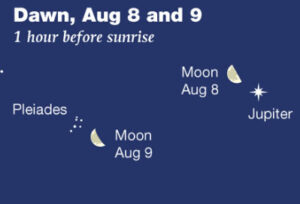Special to CosmicTribune.com, August 10, 2023
Excerpts from weekly Sky&Telescope report.
SUNDAY, AUGUST 6
■ The Big Dipper hangs diagonally in the northwest after dark. From its midpoint, look to the right to find Polaris (not very bright) glimmering due north as always.
MONDAY, AUGUST 7
■ A few Perseids trickle in starting in late July, then they build for a couple of days toward their peak, which this year is predicted for the night of August 12-13. The sky then will be moonless for perfect meteor-watching conditions. See August 12 below. The later in the night the more abundant the meteors.

■ Last-quarter Moon tonight. The Moon rises around 11 or midnight tonight with Jupiter following just a couple degrees below it. The Pleiades look on. Far below the Pleiades and Aldebaran, Orion is beginning its emergence before sunrise.
TUESDAY, AUGUST 8
■ As summer progresses, bright Arcturus moves down the western side of the evening sky left of the Dipper.
THURSDAY, AUGUST 10
■ Mercury and fainter Mars, low in the evening twilight, remain less than 5° apart from now through August 16th.
FRIDAY, AUGUST 11
■ August is prime Milky Way time, and there’s no Moon tonight. After dark, the Milky Way runs from Sagittarius in the south, up and left across Aquila and through the big Summer Triangle very high in the east, and on down through Cassiopeia to Perseus rising low in the north-northeast.
SATURDAY, AUGUST 12
■ The Perseid meteor shower should be at its peak late tonight, and the sky is moonlessly dark. In early evening the meteors will be few, but those that do appear will be long, lovely Earth-grazers skimming far across the top of the atmosphere. As the hours pass and the shower’s radiant point (in northern Perseus near Cassiopeia) rises higher in the northeast, the meteors will become shorter and more numerous — the most so from midnight to dawn.
Layer up warmly even if the day was hot; remember about radiational cooling into a clear sky! A sleeping bag makes good mosquito armor, and use DEET on the parts of you that remain exposed. Bring a reclining lawn chair to a dark, open spot where no local lights get in your eyes. Lie back and gaze up into the stars. Be patient. As your eyes adapt to the dark, you may see a meteor every minute or so on average as night grows late. You’ll see fewer under light pollution, but the brightest ones will still shine through.
The best direction to look is wherever your sky is darkest, usually overhead. The shower’s radiant is the meteors’ perspective point of origin, if you could see them coming from far away in space. But the meteors only become visible in their last second or two when they rip into the upper atmosphere, and this can happen anywhere in your sky.
SUNDAY, AUGUST 13
■ The brightest star high in the southeast these evenings is Altair, with little orange Tarazed above it by a finger-with at arm’s length.

You must be logged in to post a comment Login